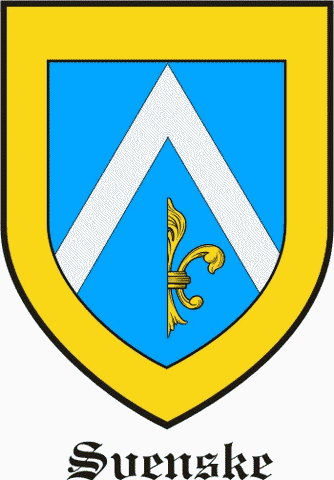Heraldry in Sweden Part 2

The result of this is that the present day functions of the Statsheraldiker, apart from dealing with issues regarding existing Arms amongst the nobility of Sweden, is to grant new Coats of Arms only to new Knights of the Seraphim, who since 1975 can only be members of the Swedish Royal Family or foreign heads of state. The Statsheraldiker also registers Coats of Arms to corporations, public communities, towns and counties. With regards to Arms for Corporations and Municipalities the drawings for the proposed Arms are submitted to the government for approval. The Heraldic officers elaborate the blazon of arms and submit the drawings to government. Following approval by the government letters patent signed by the King and countersigned by a cabinet minister are issued. The government also grants military ensigns. In the case of the Coats of Arms for Knights of the Order of the Seraphim ( image below) they are granted by the King as Lord and Master of the Orders of Knighthood. The Royal Order of the Seraphim (Seraphim being a category of Angels) is a Swedish Royal order of chivalry created by King Frederick I of Sweden on 23 February 1748, together with the Order of the Sword and the Order of the Polar Star. After the reorganization of the orders in 1975 the order is only awarded to foreign heads of state and members of the royal family (the last non-royal Swedish holder was Sten Rudholm).
 Unlike other parts of Western Europe, where lines are drawn between the ennobled, the noble, and the ancient noble or gentleman, there are no distinctions between nobility in Sweden. It has been suggested that the need for such distinctions never arose in Sweden because of the firmly organized character of the Swedish House of Nobles, which was able, without difficulty, to estimate the status of any family in the realm. Proof of nobility has never been demanded in the case of Swedish orders of knighthood as they were usually conferred only upon those who could prove a position of nobility equivalent to those in other orders who could prove their noble descent. The Swedish heraldic authorities have always been aware that, beginning with German merchants in the Middle Ages, visitors brought their own Arms with them and used them on their seals. Such uses were not recognized by the state however, and also could have no protection under Swedish law. On August 10th 1762 the King of Sweden issued an edict prohibiting common men to use “ noble arms and open helmet “ and this law is still in effect both in Sweden and neighboring Finland
Unlike other parts of Western Europe, where lines are drawn between the ennobled, the noble, and the ancient noble or gentleman, there are no distinctions between nobility in Sweden. It has been suggested that the need for such distinctions never arose in Sweden because of the firmly organized character of the Swedish House of Nobles, which was able, without difficulty, to estimate the status of any family in the realm. Proof of nobility has never been demanded in the case of Swedish orders of knighthood as they were usually conferred only upon those who could prove a position of nobility equivalent to those in other orders who could prove their noble descent. The Swedish heraldic authorities have always been aware that, beginning with German merchants in the Middle Ages, visitors brought their own Arms with them and used them on their seals. Such uses were not recognized by the state however, and also could have no protection under Swedish law. On August 10th 1762 the King of Sweden issued an edict prohibiting common men to use “ noble arms and open helmet “ and this law is still in effect both in Sweden and neighboring Finland.



